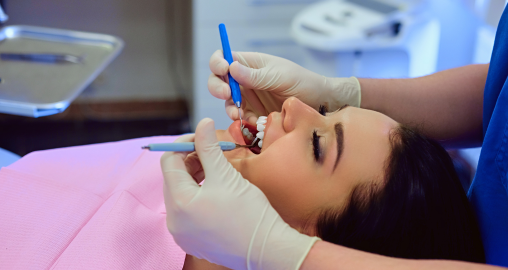Filling
Dental Fillings – What Are They and Why Might You Need One?
Dental fillings are a common treatment used to restore teeth that have been damaged by decay, minor fractures, or wear. The most frequent cause is tooth decay (dental caries), but fillings may also be needed for teeth affected by:
- Chipping or cracking
- Excessive tooth wear from grinding (bruxism)
- Nail-biting or other habits
- Injury or trauma
At Ghauri Dental Centre, our skilled dentists will assess the affected tooth, remove any decayed tissue, and restore the area using the most appropriate filling material for strength, comfort, and a natural appearance.

Direct Fillings – Composite, Amalgam, and Glass Ionomer
Direct fillings are placed during a single appointment and are the most common type of restoration. We offer a range of materials tailored to your needs:
White Fillings (Composite Resin)
- Tooth-coloured and blend naturally with your smile.
- Ideal for front teeth and visible areas.
- Preserve more natural tooth structure.
- May wear faster than amalgam in areas under heavy pressure.
Glass Ionomer Fillings
- Release fluoride to help protect the tooth from further decay.
- Typically used in areas that are not subject to strong biting forces
- Often used for children or temporary restorations.
Amalgam Fillings
- Durable, long-lasting silver-coloured fillings.
- Commonly used on back teeth where chewing forces are greatest.
- Require more shaping of the tooth.
- Offered through NHS dental care.

Note: If you prefer a more aesthetic, tooth-coloured option where not covered by the NHS, private treatment is available. Speak to your dentist for advice.
Indirect Restorations – Crowns, Inlays, Onlays, Veneers
When the damage is too extensive for a standard filling, an indirect restoration may be recommended. These are crafted outside the mouth and typically require two appointments.
Types of Indirect Restorations:
- Crowns – Cover the entire tooth for strength and protection, especially after root canal treatment.
- Inlays & Onlays – Custom restorations bonded inside (inlay) or over (onlay) the tooth.
- Veneers – Thin porcelain or composite layers applied to front teeth for cosmetic enhancement.
These precision-made restorations are designed for longevity, function, and a seamless aesthetic finish.


How Long Do Dental Fillings Last?
The lifespan of a filling depends on the material used, the location in your mouth, and habits like grinding or chewing hard foods.
- Amalgam Fillings: 10–15 years or longer.
- Composite (White) Fillings: Around 5–10 years.
- Glass Ionomer Fillings: Typically 3–5 years.
Over time, fillings can wear out, crack, leak, or fall out. That’s why regular dental check-ups are essential — they help us detect early signs of wear and repair or replace fillings before problems arise.
When Should You See a Dentist About a Filling?
Contact us if you notice any of the following:
- Toothache or discomfort while chewing.
- Sensitivity to hot, cold, or sweet food and drinks.
- Visible cracks or wear in your existing filling.
- Food getting trapped in the tooth.
- A filling that has come loose or fallen out.
Early action can save the tooth from further damage or infection. Our team will advise you on the best treatment to restore comfort and function.

